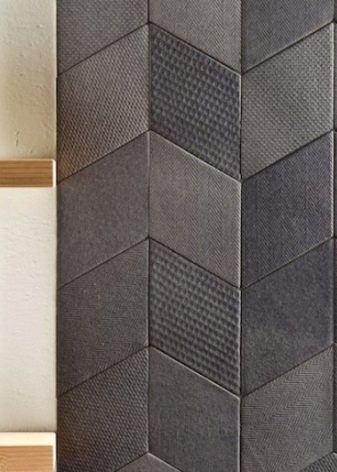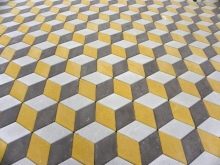Rhombus tiles in interior design

Diamond-shaped tiles are a building material with which walls are faced, giving them an original pattern. This pattern combines the features of austerity with luxury. The stylish finish looks very unusual at the same time.


Features and Benefits
Diamond-shaped ceramic tiles are the material for typical tile cladding, while retaining all the characteristics inherent in this type of finish. Among the many advantages of such products are durability, durability, and easy maintenance. There are only two types of products, with the help of which a rhomboid pattern is created:
- Square, which, when properly laid, will create a three-dimensional picture of the decor.
- A diamond-shaped quadrangular tile with different degrees of angles.


Understanding the finishing materials in more detail, it is important to highlight the ceramic tiles to create a diamond-shaped pattern. Today, the most in demand are models that, after laying, resemble a volumetric coating of fabric or leather. Their appearance is similar to the inner upholstery of carriages, which were often used by the aristocrats of Europe in the century before last. The design of such a cladding really inspires a sense of luxury as it looks rich.
The standard size of one segment is 100x200mm. The range of colors is wider - the colors can be: white, burgundy (leather), blue, green, black. Like any ceramic tile, this material can have a glossy surface, which is great for a bathroom decorated in a monarchical style... As for the inserts framing the elements, they can be made in the form of a tight seam with a thread, which enhances the similarity with natural materials.


This design is appropriate for a bedroom, study, bathroom and other rooms, giving them a luxurious look.
It is not required to cover the entire wall with this finish. You can tile the area near the bed, the body of the fireplace or part of the kitchen.



Views
Square tiles
The characteristics of this variant are practically identical with the diamond-shaped elements. These tiles are also made with a glossy finish or may look like leather. Golden inserts, as well as details in the form of a seam, can be attached to it. The standard dimensions for such large-type products are 200x200mm, and for small ones - 100x100mm.


Mosaic pattern
The versatility of the quadrangular tile makes it possible to carry out various original patterns in the form of stars, grids or volumetric images. For such designs, special inserts made of metal, glass, wood and other suitable materials are provided.



Paving slabs
Since we are talking about a unique diamond-shaped tile finish in this article, we cannot ignore the common material for the decoration of sidewalks. In addition to a durable, wear-resistant coating, such models are able to create an original pattern that perfectly complements the design surrounding them.
This option allows you to create a three-dimensional drawing thanks to the configuration of the color palette, therefore, it will not be difficult to depict a multi-pointed star or "cube".



A kind of diamond-shaped paving slabs
To date, there are no clear requirements put forward by the state for the manufacture of tiles, therefore each manufacturer provides products created using its own technology.As a rule, sizes range from 15x25cm to 19x33cm. For a pedestrian sidewalk, the thickness of stones can be from 4 cm, and for highways, it often reaches 7 cm.
There are also individual products that China manufactures, designed to facilitate the installation process. These are peculiar "halves" of a rhombus:
- The transverse half is an isosceles triangle, the upper corner of which is sharper than the lateral ones.
- The longitudinal half is a triangle with a blunt apex.

Despite its purpose (to reduce the cost of laying by eliminating the cutting of tiles), such products are much more expensive, therefore they are rarely used in work.
As for the color, it can cover only the upper (front) part of the stone up to 3 cm thick, and also completely paint the rhombus. There are more than 30 different shades on the market.



The border that decorates tiled sidewalks and courtyards also comes in different colors. It can be the same or different from the color of the tile. Its role depends on this - it can only limit the sides of the coating, merging with it, or it can serve as a separate element of the ornament, standing out against the general background.
Drawing construction
For many types of FEM (shaped paving elements), separate laying schemes are provided, describing the position of the longitudinal seams or the elements themselves in relation to each other. Methods for setting materials of different colors to form a specific pattern are also described. A distinctive feature of the diamond-shaped paving slabs is the correct symmetrical shape, which facilitates the installation process:
- The connection of three identical diamond-shaped elements forms a regular hexagon.
- Six of these tiles are capable of forming a six-pointed star.
- When laying, you do not have to cut the elements, which will reduce labor costs.



The combination of figures in three different colors allows you to create three-dimensional images.
Laying schemes
Due to the symmetry of the PEM, the segments are stacked next to each other, joining the edges. The pattern can be drawn exclusively from tiles of different colors. The seams between the elements cannot be displaced, however, you can plan in advance the setting of rhombuses in rows relative to each other on winding and rounded sections.
You will still have to cut the segments, since whole rhombuses can fit on the sidewalk, observing only one specific pattern:
- No picture picture.
- It is necessary to dock the side edges of the first row with the border.
- Lay an even number of rows to achieve symmetry.


But even here you cannot do without cutting the tiles on the end parts of the sidewalk.
Six pointed star
It is recommended to use this ornament exclusively on large areas. The diagram for the figure is as follows:
- Six identical segments are taken.
- The sharp corners of the six rhombuses are connected at one point - the center of the star.
- Then you need to create a contour with six diamonds of a different color.


Such figures can touch each other by "rays", and also be separated by other tiles (over considerable distances).
Hexagon
No less popular is the styling option, in which a regular hexagon is formed. Some people call it a "cube" (it looks like a cube, the view of which opens from one of the corners).
Here, to form a pattern, you need to take three rhombuses and connect their obtuse corners at one point. The figure has a smaller (compared to the star) size, so it is easier for her to decorate the flooring. Convex options are designed in the same way.


3D drawing
To create a volumetric image, you need to use the "hexagon" scheme. Moreover, all three elements must be of different colors. These figures are located one next to another (in a clear sequence). You can complicate the drawing by using other schemes that give the pattern three-dimensionality, which will pleasantly surprise the guests of the yard.
Whatever the 3D drawing, the masters recommend sticking to a simple combination - two dark elements at the bottom and one light at the top.This will make the "cube" appear more realistic. In this sequence, the image will look like the steps of several stairs, located one next to the other.


Please note that the combination of certain colors does not give a 3D effect. In this case, a "flower" is obtained - another scheme for laying paving slabs.
Geometric figure
The most common design for a courtyard is a sequential or chaotic complex pattern. A canvas of hexagons will fill the circle well, and for large areas, you can lay out stars, snowflakes and other multifaceted shapes.


Summing up
Diamond-shaped tiles, regardless of the purpose, whether it is a wall cladding of a bathroom, a kitchen, or a sidewalk or courtyard covering, is able to create an original pattern, complementing the decor with a unique pattern that will never get bored. In addition, due to its shape, it is easy to lay it, and it serves as a convenient material for creating paintings, therefore it is so in demand among designers and decorators.



But you should be careful when using tiles, because the pattern is created forever, and it will be extremely difficult to remove irregularities or errors later.
A master class on creating a pattern in the form of rhombuses with tiles, see below.













The comment was sent successfully.